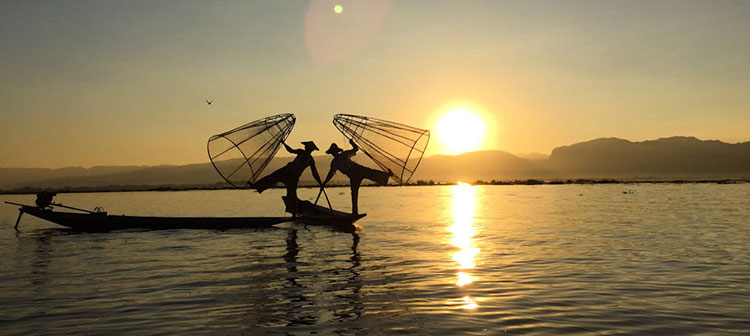
Inle Lake:
This vast and picturesque lake is situated in the hilly Shan State in the eastern part of Myanmar. With an elevation of 900 meters above sea-level, it is one of the main tourist attractions in Myanmar. The lake, 22 km long and 10 km wide, has a population of some 150,000, many of whom live on floating islands of vegetation. Inle Lake, natural and unpolluted, is famous for its scenic beauty and the unique leg-rowing of the Inthas, the native lake-dwellers. Moreover, floating villages, colorful daily floating market and Inle Spa are places worthy of visit. The festival of Phaung Daw Oo Pagoda in Inle Lake held during October is full of pageantry and colorful splendor.
How to get there:
The most convenient way is to fly from Yangon, Bagan or Mandalay to Heho, which is the nearest airport to the lake. There are daily flights to Heho. If you are flying from Mandalay to Heho, it takes only 20 minutes. Traveling by car along the uphill and winding road over the Shan Plateau is interesting and well-worth taking although it takes long hours. There is also a regular train service via Thazi Junction to Heho and Shwe Nyaung, the nearest station to the lake.
Ywama:
The largest village on the Inlay Lake; its streets are a web of canals. There are some beautiful teak houses built on large wooden piles driven into the lake bed. The main activity and attraction is at the floating market In the largest canal. It is to the North West of our hotel. By boat, it will take 15 minutes. The magnificent floating market is renowned. You can visit the goldsmith workshops, observe the sculpture and umbrella industries.
Phaung Daw Oo Pagoda:
One of the famous principal shrines in Myanmar, this pagoda houses five small Buddha images, which are much revered by the lake-dwellers. Once a year, in late September – early October, there is a pagoda festival during which, four of the five Buddha images tour around the lake in a colorful barge.
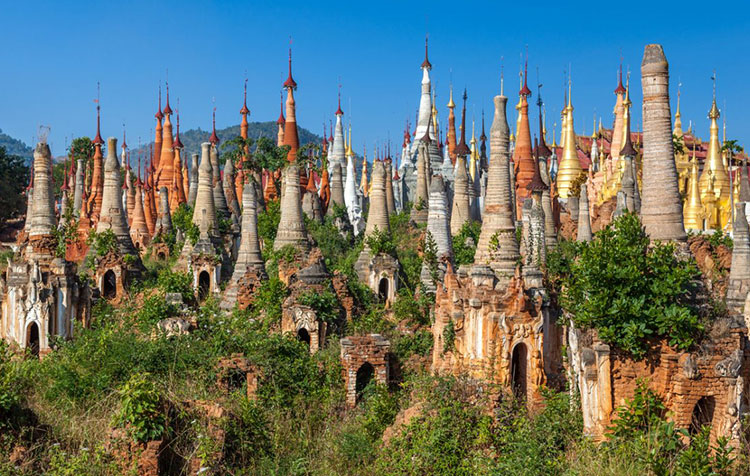
Indein:
One of the small villages of Inle Lake located on the western bank of the lake. The ruin pagodas, hide in the bushes will give you an impression of you were in the 12th - 13th Centuries ago. This mysterious place is at the end of the marvellous Indein creek, which connected with Inle Lake just after the Phaung Daw Oo Pagoda. The creek is narrow with many twist and turns. Since the both sides are paddy fields you can see the farmers ploughing and harrowing by water buffaloes. At the lunch time while groups of farmers having lunch the water buffaloes enjoy themselves dipping in the creek. At many places in the creek the farmers dam up the water by bamboo barriers to irrigate the paddy fields. Indein water is not only useful for irrigation also for bathing and washing cloths. It is compulsory to see Novice monks, buffalo boys and village girls wash and swim in the creek.
Mine Thauk Market
A large and bustling market where you can find a real local atmosphere with a variety of produce from the lake.
Nga Phe Kyaung Monastery:
This is an attractive wooden monastery built on stilts over the lake at the end of the 1850s. Aside from its collection of Buddhas the monastery may be of interest to visit because its monks have taught a few of the many cats living with them to jump through hoops.
ENVIRONS:
Taunggyi:
Over 1,430 meters above sea-level, is the capital of Shan State in the eastern part of Myanmar. A hill station known for its scenic beauty, Taunggyi is cool and pleasant all the year round. There are pines, cherry and eucalyptus trees growing all over the town and the whole area is green and pleasant. The busiest part of Taunggyi is the Myoma Market, a place where people from the environs used to flock only once every five days to buy and sell their regional products. Now it has become a daily market and is constantly crowded with people. It is also the gathering point of different national races residing in Taunggyi.
Another interesting place to visit in Taunggyi is the Cultural Museum where cultural objects, musical instruments, traditional dresses, household and farm implements, paintings, sculptures, arts and crafts of the different national races residing in Shan State can be seen. There are also 'Hawnans" (palatial residences) where the Shan Sawbwas (Shan Chieftains) used to live can also be observed.
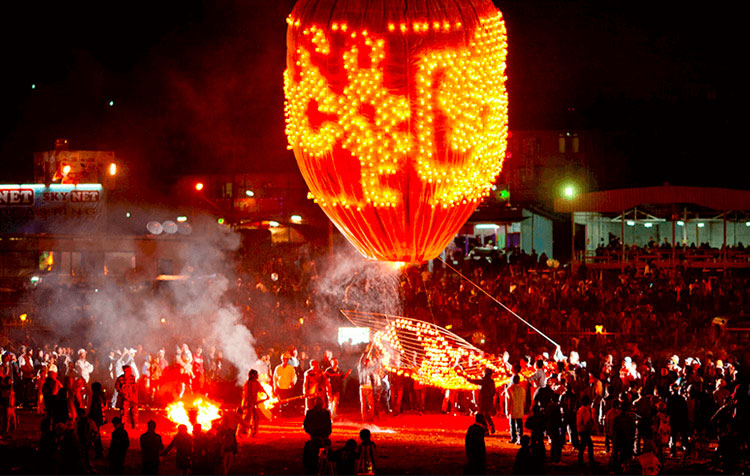
Balloon Festival in Taunggyi:
In Taunggyi, the capital city of the Shan State, the people celebrate the Tazaungdine festival with Kahtein (offering of monk robes) as well as the releasing up fire-balloons into the sky. Balloons in the shape of elephant, ox, horse, water-buffalo, bird, pig, fish, owl and parrot are released. The Taunggyi festival is the biggest festival in the country. It is attended not only by Taunggyi Citizens but also by people from southern Shan State and many different races. Taungyi's Kahtein tradition is amazing and worthy of reverence.
Weingut Ayethaya:
Das Weingut Aythaya liegt in 1.300 Meter Höhe etwa 15 Fahrminuten unterhalb von Taunggyi und rund 45 Fahrtminuten vom Inle-See entfernt. Cabernet Sauvignon, Shiraz, Sauvignon Blanc, und Chenin Blanc gedeihen hier seit wenigen Jahren unter der Aufsicht von deutschen Experten. Rund 10.000 Rebstöcke wurden dafür aus Europa eingeführt, die heute Trauben für rund 100.000 Flaschen Wein jährlich abgeben. Vor allem der Sauvignon Blanc hat es in sich und muss den Vergleich mit guten Jahrgängen aus Europa, Chile oder Australien nicht scheuen.
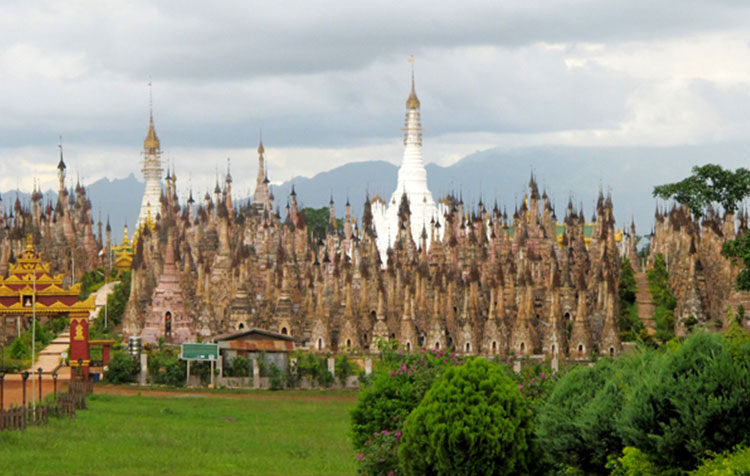
Kekku:
A hidden treasure an unusual, magnificent collection of Buddhist Stupas unheard of by historians and unlisted in guide books lies in the deepest Pa-oh territory, 26 miles south of Taunggyi the capital of Shan State. There lies more than 2000 stupas in a site closely packed together in ranks covering an area of approximately a square kilometer apparently unknown to outside world. Kekku area is covered and scattered by Pa-oh villages especially stretching along on both sides of the main road from north to south.The land route for tour groups starting from Taunggyi is possible and accessible for all year round. But tours originated from Inle Lake are considered to be possible only in the open season from late October to early May or before heavy rain falls.
The yearly religious festival normally takes about one week. The climax of this festival usually falls on full moon of the Tabaung (Mid-March) every year. The Kekku pagodas festival also draws thousands of visitors from all parts of the Shan State.
Kalaw:
Kalaw, another hill station as well as peaceful summer resort nestled in pine-clad mountains, is 1,400 meters above sea-level. It is located 70 km west of Taunggyi. Many of the Tudor-style houses and English gardens of colonial days remain. In the neighborhood lie villages of Palaung and other hill tribes who come to Kalaw market held every five days in their colorful costumes, adding to the quiet attraction of Kalaw. Kalaw is a good place for hiking amid gnarled pines, bamboo groves and rugged mountain scenery. You can walk from Kalaw to Inle Lake in 2 to 3 days and stay overnight at local houses.
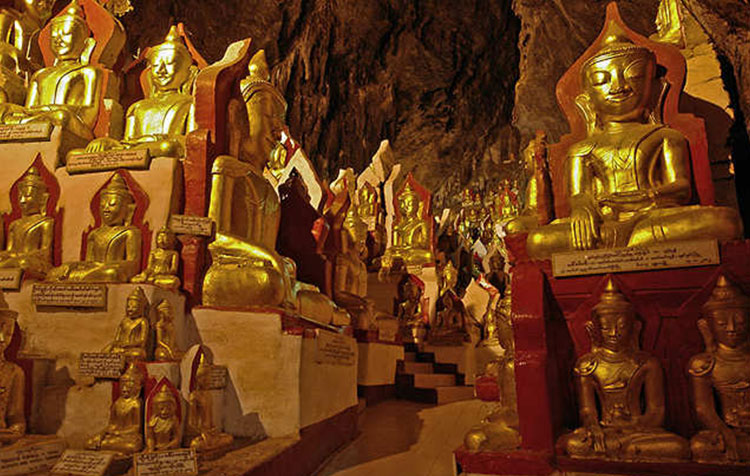
Pindaya Caves:
Pindaya is a small quiet town perched on the bank of the palcid Botoloke Lake. Pindaya cave is a huge cavern where hundreds and thoundsands of Buddha images in various size and shape are installed since the 11th century. The winding galleries and nooks and corners are ideal places of insight meditation since the olden days. Huge monastery compounds with numerous pagodas and temples in different stages of dilapidation are much respected by such ethnic groups as the Shans, Danus and Paos living in the environs of Pindaya.







